#National VFW Day
Explore tagged Tumblr posts
Text
09/29/2024 is European Heritage Day 🇦🇹, World Heart Day ❤️🌎, National Attend Your Grandchild's Birthday 🇺🇸, National Coffee Day ☕️🇺🇸, VFW Day 🇺🇸, National Gold Star Mother's Day 🇺🇸, National Police Memorial Day (ACAB) 🇬🇧, International Day of Awareness on Food Loss and Waste Reduction 🇺🇳

#european heritage day#world heart day#national attend your grandchild's birthday#national coffee day#vfw day#national gold star mother's day#national police memorial day#international day of awareness on food loss and waste reduction
1 note
·
View note
Text
Poem V (F) W
by Frank O'Hara
I don’t know if you doubt it but I think you do I am independent of the Cabaret Voltaire the Café Grinzing the Black Cat the anubis two parallel lines always meet except mentally which brings on their quarrels and if I sit down I admit it is not at a table underneath elms to read you were walking down a street softened by rain and your footsteps were quiet and I came around the corner inside the room to close the window and thought what a beautiful person and it was you no I was coming out the door and you looked sad which you later said was tired and I was glad you had wanted to see me and we went forward back to my room to be alone in your mysterious look among the relics of postwar hysterical pleasures I see my vices lying like abandoned works of art which I created so eagerly to be worldly and modern and with it what I can’t remember I see them with your eyes
(as printed in The Collected Poems of Frank O'Hara ed. Donald Allen)
#national poetry month#day 9#i wasn't sure which frank to do#thought about doing for grace but that's easy to find online and poem vfw is not#i love this poem#it's right next to having a coke with you for me in terms of my favorite love poems of his#and of course both have so many weird interesting things in common#this idea that the act of love is an act of looking and that love refreshes looking#and i think there's something beautiful in that in this poem this gay man wrote for his boyfriend love literally makes a room and a new wor#world#idk#both are for vincent warren thats the vfw#again im trying not to repeat poets but we may see frank again i love him so much#oh lana turner we love you get up etc etc
3 notes
·
View notes
Text


Geoff Rickly in ‘Negatives’ by Amy Fleisher Madden
Transcript below
An Introduction to the Third Wave
Geoff Rickly
Thursday / No Devotion / United Nations
Everything is hardcore. Snapcase is hardcore.
Obviously. Strife and Chain of Strength and Bad Brains are hardcore. Sick of It All is hardcore, and they're from New York, so they spell it NYHC.
Shelter is hardcore and 108 is hardcore, and they're both Krishna, which means people call them Krishnacore. Earth Crisis and SSD are hardcore, but they don't do drugs; straight-edge hardcore.
There are so many little signifiers in place to help people know what's up, but each one of these bands does actually have something in common: They are all hard as nails. They're hardcore.
It was the mid-'90s. I'd moved out of the dorms at Rutgers and into a house on Somerset Street with my old roommate, Clay, and my new housemate, Louis. We were a good twenty-minute walk from campus, but the house was weirdly small on the inside; it got bad light. But it had a big basement.
Big enough to have shows in. Hardcore shows.
Luckily, by the mid-'90s, hardcore was everything, and everything was hardcore.
Converge was hardcore-full of guitars and drums that sounded like broken glass in a blender. But so was Rainer Maria, with twinkling clean guitars and dual vocals whispering and shouting in a joyous conversation. So were Ink & Dagger, in their corpse paint, smashing Aphex Twin electronics into Black Flag riffs. Fugazi was hardcore with a rhythm section that sounded like James Brown and a no-slam-dancing policy. Texas Is the Reason had twangy vocals and the most beautiful guitar parts that anyone had ever heard, and they were fucking hardcore-with the pedigree to prove it. They were one of the groups that inspired the latest wave of bands who were all playing shows in our basement, and in other basements like ours all over America: The Get Up Kids, The Promise Ring. Jimmy Eat World. They were all catchy and sweet, and full of youthful innocence. And they were all hardcore, too. Everything was. The basement show was like an Olive Garden:
If you were there, you were family-you were hardcore.
But holy shit, did we love to tease those bands— "You guys are so emotional, you're so fucking emo." Stick a tap in them and let the tears flow. That's all emo was to us: a taunt, a ribbing, a genre label that had never really stuck. I remember seeing Fugazi in the early '90s and someone yelled at lan MacKaye, "You are so emo!" His reply was simple and seemed to shut down the label forever. He said, "Emo Philips?" —forcing the crowd to think of the awkward comedian, with his strange bob haircut.
So, years later, when we had a great young hardcore band from Princeton play in our basement, we shouted at them, "Oh my god, Saves the Day are so emo." Their singer, Chris, acknowledged it dryly: "Boo hoo." Or that time when At the Drive-In destroyed the Melody Bar in front of a crowd of five people. I told them, "That was so good, I could have cried. but I didn't want anyone to thinkI was emo."
We didn't know we were already part of it. A joke or not, we were already emo. When we started Thursday, we thought we were just another hardcore band in the wave of hardcore bands that we looked up to: Saetia, You and I, Usurp Synapse, Orchid, Reversal of Man, The Locust, Charles Bronson.
Our friends. Our heroes. We were playing the same basements and VFW halls. We were buying the same vans and using the same dialers to get free calls on pay phones. We didn't know that, even as our own band took off, we were already emo, and we were about to be part of something new.
After Full Collapse came out on Victory Records-a very hardcore label —we spent a lot of time tracing the footsteps of all those who d come before. We played to five or ten people a night, occasionally landing a festival where we'd do anything to get people to stick around. "Yeah, we have a three-way split with Joy Division and Swing Kids, but we're sold out of them right now... Still, we're playing after Dragbody if you've got the time to watch us."
Then Saves the Day offered us a spot opening for them on a national tour. Our friend Dan from the band Joshua explained to us that Saves the Day was the biggest band in hardcore. They'd hit the indie glass ceiling-they'd sold 100,000 records without being on a major label. We took the tour - first of four in front of 1,000 people every night-and something clicked. The very next tour we went out on, we were the headliner, and it was entirely sold out before we even left home. Something was happening. We broke through the 100,000 record glass ceiling, shooting to 400,000 records. All our friends were right behind us, in the next couple years, hitting a million records sold and more.
The press has always been a little tone deaf, and they'd already been using the term emo for years, so they tried to find something new and catchy for this rapidly developing phenomenon. They tried screamo, except not everyone was screaming- and the bands hated it. Emocore, except that term somehow sounded even wimpier than just emo-and the bands hated it. They even tried the term xtremo, and tried to line us up to play X Games-type events, with cans of Mountain Dew stacked on our amps, but the sponsors weren't sure about the crossover appeal-and the bands hated it.
[photo id: geoff leaning back into the crowd. he is shouting, with one arm raised above/behind his head and crowd members’ arms round his torso]
In the middle of all this, I had the chance to produce the first album from a scrappy bunch of hard. core kids who loved Placebo and Queen and comic books. They were called My Chemical Romance, and by their second record, they would solidify something that had been becoming apparent for the last couple of years: The 2000s were the decade of emo. It was everywhere. It was fashion and TV and billboards. It was celebrity. It was gossip.
And when money gets involved, things can quickly go to shit. Emo got increasingly commercial. It was codified. It was slick. It had songwriters and mega producers. It had A-listers directing music videos.
The only thing it lacked was sincere emotion. The feeling was gone. A pretty tough break for a genre called emo.
By the 2010s, being emo was about the uncoolest thing in the world. The heavy hitters started breaking up. Not just the early torchbearers like us or our West Coast buds, Thrice, but the big guns, too.
My Chemical Romance called it quits, and suddenly bands started dropping likeflies. Pop singers dropped the emo haircuts. Things cooled off.
But then, half a decade later, something strange started to happen. The young kids began to go back to the roots of the genre, appreciating the earnest sincerity and adventurous musicality that made emo break out in the first place. The Hotelier, Teen Suicide, The World Is a Beautiful Place & I Am No Longer Afraid to Die, Joyce Manor, Hop Along-these bands brought emo out of the boardroom and back into the basement, bashing away at a glorious noise until the world started to notice. This
"emo revival" was actually the birth of something new. It inspired Thursday to start playing again, and it inspired so many of our peers to do the same.
We've gotten the opportunity to see this thing that we gave our hearts to through newer, purer eyes.
Watching Pianos Become the Teeth and Title Fight and Touch�� Amoré burn with passionate intensity has reignited our fire. Seeing these photos, through Amy's eyes- seeing the vitality that has always been there-is much the same. It's changed everything, allowing us to restore a true relationship to our past work.
Recently, I had the opportunity to stand on stage with Thursday and watch a sea of kids scream along to these words from "War All The Time":
All those nights in the basement,
The kids are still screaming
On and on and on and on and ...
And it was pretty hardcore-emotionally speaking.
6 notes
·
View notes
Text
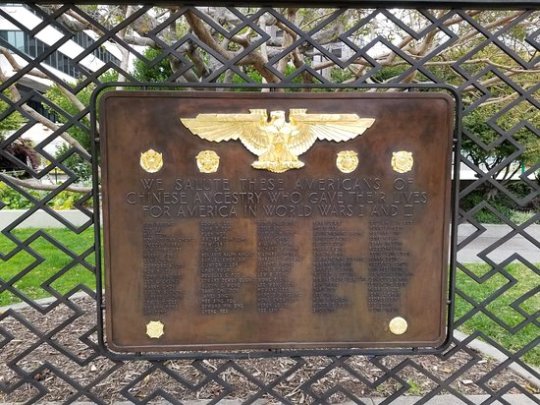
The then newly-restored plaque in St. Mary’s Square honoring the “Americans of Chinese Ancestry” who gave their lives for America in its world wars, November 10, 2018. Photograph by Doug Chan.
The Last Full Measure: St. Mary’s Square Monument to the Fallen of Chinese America
In his book San Francisco Chinatown: A Guide to its History & Architecture, historian Philip P. Choy, shared his observations about the monuments in St. Mary’s Square as follows:
“Across from the statue of Dr. Sun Yat-sen is a less imposing but more significant monument, with 97 names of Chinese American soldiers of our community, who made the supreme sacrifice in World War I and II. Every year on Veterans Day, the Cathay Post No. 384 and the VFW Chinatown Post march to the square to honor those who died for us, that they never be forgotten. This commemorative plaque and day of remembrance are more symbolic of Chinese America than Sun Yat-sen’s statue and the “Ten Ten” celebration.”
During the Second World War, thousands of young men and women enlisted or were drafted from Chinatowns, Japantowns (and concentration camps), Manilatowns, and other small communities across the country.
According to the U.S. Department of Veteran Affairs and researchers at the Oakland Museum, 13,499 Chinese American men fought in the armed forces. (Community estimates range as high as 20,000.) Approximately 75 percent served in the US Army, with ground units such as the 3rd and 4th Infantry Divisions in Europe and the 6th, 32nd and 77th Infantry Divisions in the Pacific. A quarter of the total Chinese American personnel under arms served in the Navy. Still others served in specialized units, such as the all-Chinese American 1157th Signal Corps -- part of 14th Air Service Group that would join the fight against Imperial Japan in the China Burma India theatre of operations.
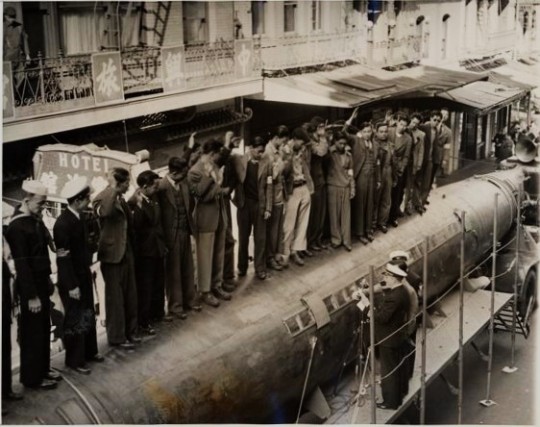
Group of Chinese recruits for the U. S. Navy taking their oath on top of a captured Japanese submarine, on Navy Day in San Francisco Chinatown, October 27, 1942. Associated Press photographer unknown (from the collection of the San Francisco Public Library). As written on the verso: ""A two-man Jap submarine, captured after the sneak attack on Pearl Harbor, T.H. [Territory of Hawaii], began its nation-wide tour in San Francisco Oct. 27. In Chinatown, Chinese recruits for the U.S. Navy lined up on the vessel and took their oath. It was part of Navy Day ceremonies."
The Chinese American men who served in the armed forces during WW II comprised 20 percent of all such men in the continental U.S. As historian Iris Chang would write decades later, “ethnic Chinese men gave their lives disproportionate to their presence in the country.”
As in many cities, the public spaces in San Francisco had included memorials to the fallen in America’s wars. On Memorial Day on May 30, 1919, city officials and thousands of spectators dedicated a 15-acre plot as the “Grove of Heroes,” in remembrance of the US dead and wounded in the First World War. In 1930, a sculpture originally created by M. Earl Cummings for the Pan Pacific International Exposition was acquired and installed in the meadow adjacent to the grove. The bronze figure holding a laurel wreath became known as the “Doughboy Statue,” and it is readily noticeable from the park’s John F. Kennedy drive and promenade. On Armistice Day (now known as Veterans Day), November 13, 1932, public officials assembled again to dedicate an 18-ton granite boulder (reportedly quarried from Twin Peaks) to commemorate US war dead. The monument, which was sponsored by the Native Sons of the Golden West, was inscribed with the names of 748 men and 13 women, all local soldiers and volunteers who died during the Great War.
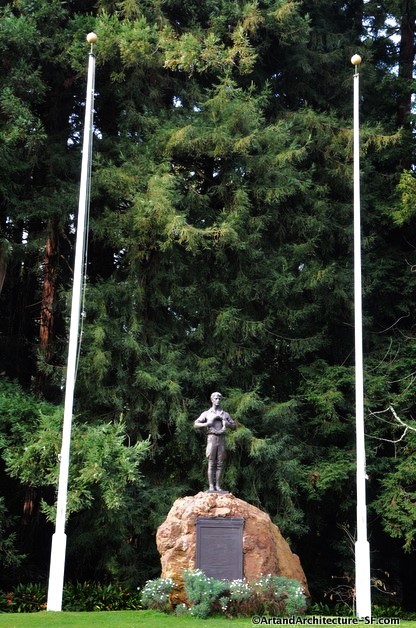
The Doughboy Statue in the “Grove of Heroes” in San Francisco's Golden Gate Park. The plaque, sponsored by the Native Sons of the Golden West and inscribed with the names of US dead in two world wars, omits the names of non-white military personnel killed in the line of duty.
Although Chinese Americans had served and died in WW I, no Chinese names had ever been inscribed in any of San Francisco’s war memorial monuments from that era. Their omission was hardly surprising. The Native Sons of the Golden West had been founded in July 1875 as a fraternal organization "embracing only the sons of those sturdy pioneers who arrived on this coast prior to the admission of California as a state." In the 1920s, the Native Sons adopted a white nativist stance on public policy issues. President William P. Canbu of the Native Sons wrote that “California was given by God to a white people, and with God’s strength we want to keep it as He gave it to us.” The Native Sons openly opposed Chinese, Mexican, and Japanese immigration. At the outset of the Second World War, the organization waged an unsuccessful legal battle for Japanese Americans to be disenfranchised.
The size of the returning cohort of Chinese American men (and the few women) from the Second World War had been unprecedented, and they produced a transformative generation of determined civic activists in the postwar era. As was the case with many other communities of color in the country, Chinese Americans had to struggle for acceptance and civil rights. Community activists such as John C. Young, a retired colonel from the United States Army and World War II veteran, made it their mission to join the struggle for Chinese Americans’ civil rights and participation in mainstream society. Young’s family led that effort by example as one of the first Chinese families to buy a home in defiance of racially-restrictive covenants against homeownership in San Francisco’s Richmond District (See the story here: https://www.outsidelands.org/chinese-in-the-richmond-alfred-john-young-and-connie-young-yu.php)
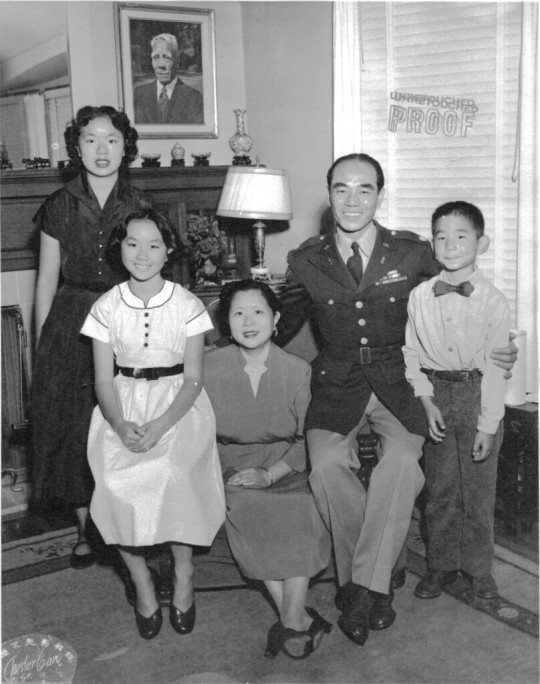
Left to right: Janey Young Cheu, Connie Young Yu, Mary Lee Young, Lt. Col. John C. Young, and Alfred John Young in the Young family house at 674 37th Avenue, circa 1952. (Courtesy of Al Young)
With the onset of the Cold War and actual armed conflict on the Korean peninsula, Chinese American leaders sensed that the path toward progress and acceptance of Chinese Americans had been jeopardized by the People’s Republic of China’s deploying troops to support North Korea’s military against UN forces.
As a commander of the American Legion Post #384 (Cathay Post), John Young and his fellow veterans spearheaded a proposal to erect a war memorial to the fallen Chinese American Veterans of World War I and World War II.
In 1951, the same year in which the Native Sons added the names of 16 white members who had died in World War II to the plaque on the rock pedestal of the Doughboy Statue, Chinese American veterans’ proposal to honor their fallen comrades in Chinatown gained acceptance.
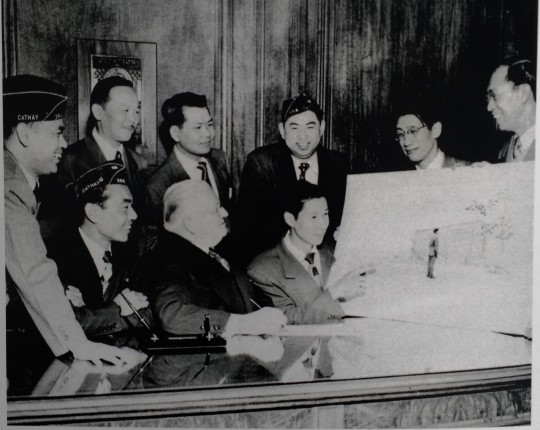
Members of the VFW Chinatown post and Cathay Post no. 384 of the American Legion huddle and review conceptual drawings for a St. Mary’s Square monument with San Francisco Mayor Elmer Robinson in the Mayor’s office in City Hall, c. 1951. Standing (left to right): Lim P. Lee, Peter H. Wong (unidentified veteran), Shaw Pange, Charles Leong, and Joseph Quan. Sitting: John C. Young, Mayor Elmer Robinson, and James Hall. Photographer unknown (from the collection of the late Col. John C. Young and his daughter Connie Young Yu).
Before 1951, a large and dramatic stainless steel statue of Dr. Sun Yat-sen, designed local sculptor Benny Bufano, represented the principal statuary in St. Mary's Square.
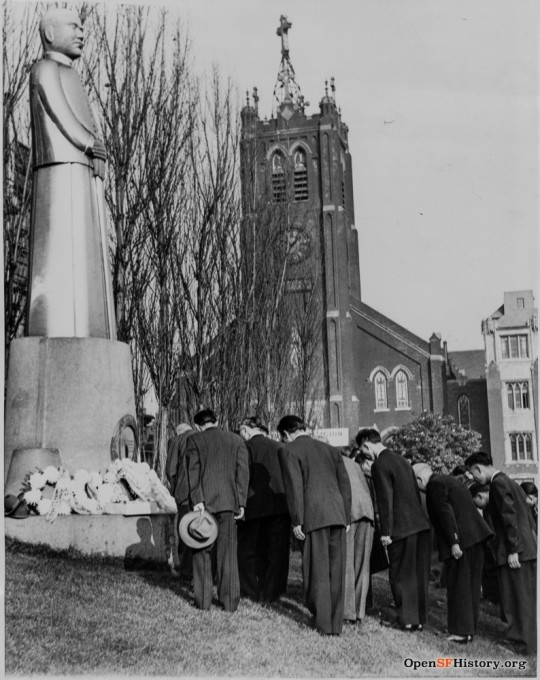
St. Mary's Square Nov 12, 1943. In this view of St. Mary's Square, looking north toward Old St. Mary's Church, members of San Francisco’s Chinese community bow before the statue of Sun Yat Sen on the occasion of Dr. Sun’s birthday. Among those attending the ceremony was Tse Kiong Sun, grandson of Sun Yat Sen. Photographer unknown (Courtesy of a private collector).
According to historian Phil Choy, the statue had been commissioned by the Chinese Six Companies to commemorate October 10, 1911, the day Dr. Sun's revolutionary party overthrew the Manchu government and established the Republic of China. As Choy wrote in 2012:
“For almost a century, October 10th, known by the Chinese as “Ten Ten,” was a major day of celebration in the community. Banners stretched across Grant Avenue. Organized by the Chinese Six Companies, drum & bugle corps and pupils from every Chinese language school dutifully paraded through the streets. Today the celebration no longer has 100% community support. Members of the Chinese Six Companies are divided; some still embrace the Kuomintang (KMT) Party of the former Republic of China (now the Taiwanese Government), while others support the People’s Republic of China.”
The efforts by the Chinese community’s veterans and supporters to honor the fallen of two world wars culminated in 1951 with the installation of the memorial plaque still seen today in St. Mary's Square. (A recounting of the memorial's dedication and other recollections by the daughter of one of the leaders in the effort to establish the monument, historian Connie Young Yu, may be heard here. (https://chiamgi.substack.com/p/col-john-c-young-profile?triedRedirect=true)
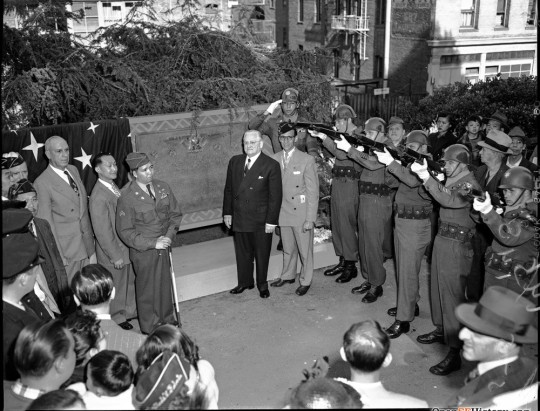
“Soldiers firing salute at dedication of memorial to deceased Chinese-American veterans at St. Mary's Square,” May 28, 1951. Mayor Elmer Robinson stands at center in dark suit. Photographer Unknown (Examiner Negative Collection / courtesy of a private collector)
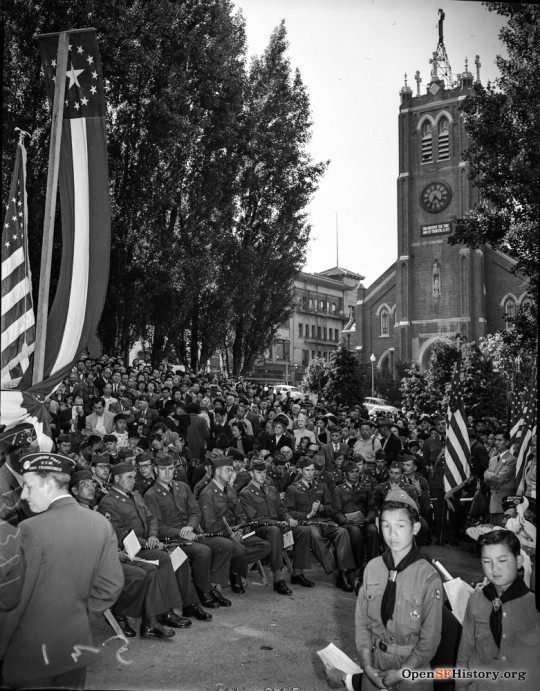
A large crowd attended the dedication ceremonies for the Chinese veterans memorial at St Mary’s Square on May 28, 1951. An Army band is seated with musical instruments, and members of the Chinatown Boy Scouts troop appear in the right foreground. Photographer unknown (form a private collection).
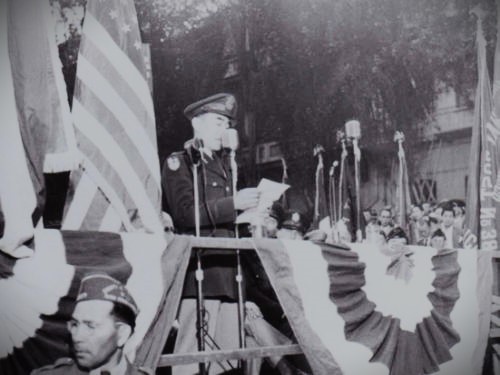
Civic leader and president of the Wing Nien Soy Sauce Co. Col. John C. Young (ret.) speaks to the crowd assembled on May 28, 1951, for the dedication of the memorial to Chinese American service personnel killed during the First and Second World Wars. His speech to the crowd occurred in the presence of his former commanding officer, General Albert Wedemeyer, under whom Young served as a heavy weapons officer in the China-Burma-India theater of operations.
If the irony of Chinese Americans' entering the US armed forces during wartime was apparent, it was never expressed publicly by those who had served honorably. Native-born, as well immigrants ineligible to naturalize as citizens by punitive immigration laws, had answered the call to service for an America that had, for most of the previous century, robbed, murdered, burned, lynched, taxed, and excluded the pioneer generations, while building much of the political economy of the American West on the strength of Asian labor.


Veterans from Chinatown's American Legion Cathay Post 384 and VFW Chinatown Post 4618 assembled on Memorial Day 2016 in front of the WW I and II memorial plaque in St. Mary’s Square to commemorate the Chinese American fallen in all the nation’s conflicts and wars. Photograph by Doug Chan.
The numbers of Chinese Americans KIA and MIA from the world wars remain imprecise. The honored dead, including Medal of Honor recipient Capt. Francis B. Wai are, and will be, remembered in perpetuity for their extraordinary heroism and devotion to duty. For others, such as Lt. Kenneth Kai-Kee, the memories, grief and loss of those he left behind have already faded with the passing of family, friends, and loved ones.
The passage of time confers on community historians the duty to impart to each new generation the mission to remember the wartime sacrifices of Chinese America's sons and daughters. The debt to those who gave the last full measure of devotion must be honored in perpetuity.
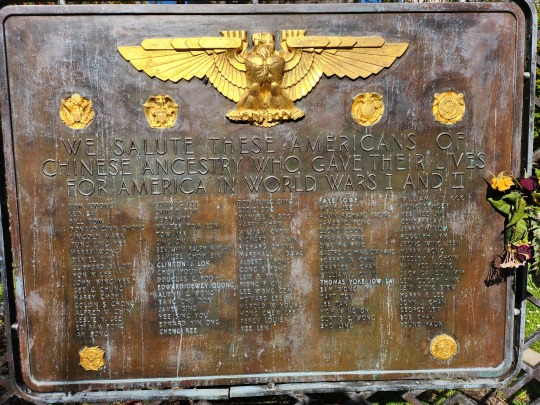
Photograph by Doug Chan.
#St. Mary's Square#Cathay Post veterans#Col. John C. Young#Francis B. Wai#Kenneth Kai-Kee#Lim P. Lee#Peter H. Wong#Shaw Pang#Charles Leong#Joseph Quan#Chinese American veterans memorial
2 notes
·
View notes
Text
KNRC to Participate in ARRL Field Day 2023
ARRL Field Day Logo 2023 Members of the Kansas-Nebraska Radio Club (KNRC) will be participating in the national Amateur Radio Field Day exercise, June 24-25, at VFW Post 7697, 601 N Railroad Ave, Glasco, KS 67445. Since 1933, ham radio operators across North America have established temporary ham radio stations in public locations during Field Day to showcase the science and skill of Amateur…

View On WordPress
2 notes
·
View notes
Text
I have lived in the United States my entire life, so over 40 years, and I have never heard of May 1st being called Loyalty Day here. Apparently, it's an anti-Labour Day holiday that's a relic of the Red Scares.
It must have fallen out of favor years ago since again, I've never heard of it, and I've certainly never seen it on a calendar.
I just spoke to my Boomer dad. He said that he doesn't remember hearing about Loyalty Day growing up. Between our two households, the only calendar that mentions it is his VFW calendar.
You'd think Fox News would be all about this holiday. *eyeroll*
I guess some nationalism things can die off if no one pays any attention to them anymore. Good to know.
2 notes
·
View notes
Text
Holidays 9.29
Holidays
Amaranth Day (French Republic)
Babi Bar Massacre Anniversary Day
Battle of Boquerón Anniversary Day (a.k.a. Victory of Boquerón Day; Paraguay)
Broadway Musicals Day
Day of Machine-Building Industry Workers (Russia)
Devil Spits Day (UK)
Diplomatic Service Employees Day (Tajikistan)
Free Web Search Day
Halsey 929 Day
Han’gawi (North Korea)
Happy Goose Day
Hidden Heroes Day (UK)
International Adhesive & Sealant Day
International Day of Awareness of Food Loss and Waster (UN)
Inventor's Day (Argentina)
Jitiya Parwa (Nepal)
Labor Day (Kazakhstan)
Leif Erickson Day
MAGS (Memphis Archeological and Geological Society) Day
Make a List of the Top 10 Happiest Days in Your Life Day
Maneki Neko Day (Japan)
Manit Day (Culture Day; Marshall Islands)
Mechanical Engineer’s Day
Mid-Autumn Festival (Taiwan)
Mutation Day (TMNT)
National Attend Your Grandchild's Birth Day
National Bot Restock Day
National Brave Day
National Carson Day
National Day of Accountability
National Day of Belongingness
National Oxygen Day
National Police Remembrance Day (Australia)
National Silent Movie Day
929 Day
Otorhinolaryngologist Day (Russia)
Quick Draw McGraw Day
Shakira Day
Sibling Support Day
Urban National Wildlife Refuge Day
VFW Day
World Daddy Lumba Day (Ghana)
World Day of Primary Immune Thrombocytopenia
World Heart Day
World Retina Day
World Tacha Day (Nigeria)
Xenophobe Understanding Day
Food & Drink Celebrations
Biscotti Day
Blackberries Day
Budweiser National Happy Hour
Coffee Day (Sweden)
Gnocchi Day (Argentina)
Happy Goose Day
Michaelmas [traditional start of Bavarian lager brewing season]
National Coffee Day (a.k.a. Coffee Lovers Day)
National Dunkin’ Day
National Mocha Day
National Poisoned Blackberries Day (Scotland)
National Starbucks Day
Swedish Fish Day
Independence & Related Days
Constitution Day (Brunei)
Villa Alicia (Declared; 2014) [unrecognized]
5th & Last Sunday in September
Banned Book Week begins [Sunday of Last Week]
Clypping the Church Ceremony (Painswick, Gloucestershire, England) [Last Sunday]
Gold Star Mother's Day [Last Sunday]
International Day of the Deaf [Last Sunday]
National Blood Donor Day (Kyrgyzstan) [Last Sunday]
National Get Outside Day [Last Sunday]
National Hereditary Breast & Ovarian Cancer Day [Last Sunday]
Police & Peace Officers’ National Memorial Day (Canada) [Last Sunday]
Priesthood Sunday [Last Sunday]
Russian Tiger Day [Last Sunday]
Seven For Sunday [Every Sunday]
Social Justice Sunday (Australia) [Last Sunday]
Souper Sunday [Last Sunday of Each Month]
Sultry Sunday [Last Sunday of Each Month]
Sundae Sunday [Every Sunday]
Sunday Funday [Every Sunday]
Tap-Up Day (Guilford, UK) [Sunday before Oct. 2]
World Day of Migrants & Refugees [Last Sunday]
World Day of Retinitis Pigmentosa [Last Sunday]
World Deaf Day [Last Sunday]
World Heart Day [Last Sunday]
World Rivers Day [Last Sunday]
Weekly Holidays beginning September 29 (Last Week of September)
National Chimney Safety Week (thru 10.5)
Restaurant Week (Westport-Weston, Connecticut) [thru 10.13]
Shetland Wool Week (thru 10.5)
Festivals Beginning September 29, 2024
Atlantic Antic Street Festival (Brooklyn, New York)
Ballinasloe Horse Fair & Festival (Ballinasloe, Ireland) [thru 10.6]
Fryeburg Fair (Fryeburg, Maine) [thru 10.6]
NBWA Convention & Product Showcase (San Diego, California) [thru 10.2]
Unsound (Krakow, Poland) [thru 10.6]
Vermont Pumpkin Chuckin' Festival (Stowe, Vermont)
Feast Days
All Angels’ Day (Christian)
Antoine Coysevox (Artology)
Arturo Lindsay (Artology)
Caravaggio (Artology)
Carl Giles (Artology)
Colin Dexter (Writerism)
Confucius Day (Confucianism)
The Daily Double (Church of the SubGenius)
Day of Hestia Tamia (Pagan)
Double Entendre Day (Pastafarian)
Feast of the Dedication of the Basilica of St. Michael the Archangel (Roman Catholic)
Festival of Tezcatzonctl (Chief Aztec God of Intoxication)
Fielding (Positivist; Saint)
François Boucher (Artology)
Gwynn ap Nudd’s Fest (Celtic God of the Underworld)
Ian Fairweather (Artology)
Luther D. Bradley (Artology)
Michael, Gabriel, Raphael (Christian; Angels)
Jacopo Robusti Tintoretto (Artology)
Michaelmas [traditional start of Bavarian lager brewing season]
Miguel de Cervantes (Writerism)
Quarter Day (England, Ireland & Wales) [3 of 4]
Rhipsime (Christian; Saint)
Rhipsime, Gaiana and Their Companions (Christian; Martyrs & Virgins)
Riding the Stang (Celtic Book of Days)
Stan Berenstain (Artology)
Tales of Kelp-Kori’s Second Visit Again (Shamanism)
Telly Monster (Muppetism)
Theodota (Christian; Martyr)
Lucky & Unlucky Days
Butsumetsu (仏滅 Japan) [Unlucky all day.]
Lucky Day (Philippines) [53 of 71]
Premieres
Alice in Slumberland (Ub Iwerks Disney Cartoon; 1926)
All the World’s a Stage, by Rush (Live Album; 1976)
Baby Wants Spinach (Fleischer/Famous Popeye Cartoon; 1950)
Best in Show (Film; 2000)
The Bicentennial Man and Other Stories, by Isaac Asimov (Short Stories; 1976)
Big Mouth (Animated TV Series; 2017)
Black Coffee in Bed, by Squeeze (Song; 1982)
Clarinet Quintet in A, written by Wolfgang Amadeus Mozart (Quintet; 1789)
Core, by Stone Temple Pilots (Album; 1992)
The Creator (Film; 2023)
Death on the Nile (Film; 1978)
Deduce, You Say! (WB LT Cartoon; 1956)
Felicity (TV Series; 1998)
Hamlet (Film; 1948)
The Headless Horseman (ComiColor cartoon; 1934)
Inhumans (TV Series; 2017)
I Yam What I Yam (Fleischer Popeye Cartoon; 1933)
MacGyver (TV Series; 1985)
Masters of Sex (TV Series; 2013)
Mickey Plays Papa (Disney Cartoon; 1934)
Moonlight and Valentino (Film; 1995)
Okie from Muskogee, by Merle Haggard (Song; 1969)
The Old Pioneer (Happy Harmonies MGM Cartoon; 1934)
Open Season (Animated Film; 2006)
Painted from Memory, by Elvis Costello with Burt Bacharach (Album; 1998)
Permanent Wave (Oswald the Lucky Rabbit Cartoon; 1929)
The Prisoner (UK TV Series; 1967)
Remember the Titans (Film; 2000)
Sackett's Land, by Louis L'Amour (Novel; 1974)
Serenade in C (a.k.a. Ganz Kleine Nachtmusik), by Wolfgang Amadeus Mozart (String Trio; 2024)
Smells Like Teen Spirit, by Nirvana (Music Video; 1991)
A Spell for Chameleon, by Piers Anthony (Novel 1977) [Xanth #1]
A Star is Born (Musical Film; 1954)
The Stranger, by Billy Joel (Album; 1988)
Superman/Batman: Public Enemies (WB Animated Film; 2009)
Tall in the Saddle (Film; 1944)
To Die For (Film; 1995)
Tony Hawk’s Pro Skater (Video Game; 1999)
Uptown Girl, by Billy Joel (Song; 1983)
Urban Hymns, by The Verve (Album; 1997)
Today’s Name Days
Gabriel, Gabriela, Michael, Michaela, Rafael, Rafaela (Austria)
Gabrijel, Mihael, Rafael (Croatia)
Michal (Czech Republic)
Michael (Denmark)
Mihkel, Miikael, Mikk, Miko, Miku (Estonia)
Miika, Miikka, Mika, Mikael, Mikaela, Mikko, Miko, Miska (Finland)
Gabriel, Michel, Raphaël (France)
Gabriel, Michael, Raphael (Germany)
Kyriakos (Greece)
Mihály (Hungary)
Gabriele, Michele, Nicolò, Raffaele (Italy)
Ivonna, Mihails, Miķelis, Mikus (Latvia)
Gabrielius, Michalina, Mykolas, Mykolė, Rapolas (Lithuania)
Mikael, Mikal, Mikkel (Norway)
Dadźbog, Franciszek, Michalina (Poland)
Chiriac (Romania)
Ludmila (Russia)
Michaela, Michal (Slovakia)
Gabriel, Miguel, Rafael (Spain)
Mikael, Mikaela (Sweden)
Teofan (Ukraine)
Carmichael, Mia, Micaela, Micah, Michael, Michaela, Micheal, Michele, Micheline, Michelle, Mickey, Miguel, Mikaela, Mikala, Mikayla, Mike, Mikel, Mitch, Mitchel, Mitchell (USA)
Today is Also…
Day of Year: Day 273 of 2024; 93 days remaining in the year
ISO: Day 7 of Week 39 of 2024
Celtic Tree Calendar: Gort (Ivy) [Day 1 of 28]
Chinese: Month 8 (Guy-You), Day 27 (Bing-Shen)
Chinese Year of the: Dragon 4722 (until January 29, 2025) [Wu-Chen]
Hebrew: 26 Elul 5784
Islamic: 25 Rabi I 1446
J Cal: 3 Orange; Threesday [3 of 30]
Julian: 16 September 2024
Moon: 8%: Waning Crescent
Positivist: 21 Shakespeare (10th Month) [Moliere]
Runic Half Month: Gyfu (Gift) [Day 8 of 15]
Season: Autumn or Fall (Day 8 of 90)
Week: Last Week of September/1st Week of October
Zodiac: Libra (Day 7 of 30)
Calendar Changes
Gort (Ivy) [Celtic Tree Calendar; Month 10 of 13]
1 note
·
View note
Text
Holidays 9.29
Holidays
Amaranth Day (French Republic)
Babi Bar Massacre Anniversary Day
Battle of Boquerón Anniversary Day (a.k.a. Victory of Boquerón Day; Paraguay)
Broadway Musicals Day
Day of Machine-Building Industry Workers (Russia)
Devil Spits Day (UK)
Diplomatic Service Employees Day (Tajikistan)
Free Web Search Day
Halsey 929 Day
Han’gawi (North Korea)
Happy Goose Day
Hidden Heroes Day (UK)
International Adhesive & Sealant Day
International Day of Awareness of Food Loss and Waster (UN)
Inventor's Day (Argentina)
Jitiya Parwa (Nepal)
Labor Day (Kazakhstan)
Leif Erickson Day
MAGS (Memphis Archeological and Geological Society) Day
Make a List of the Top 10 Happiest Days in Your Life Day
Maneki Neko Day (Japan)
Manit Day (Culture Day; Marshall Islands)
Mechanical Engineer’s Day
Mid-Autumn Festival (Taiwan)
Mutation Day (TMNT)
National Attend Your Grandchild's Birth Day
National Bot Restock Day
National Brave Day
National Carson Day
National Day of Accountability
National Day of Belongingness
National Oxygen Day
National Police Remembrance Day (Australia)
National Silent Movie Day
929 Day
Otorhinolaryngologist Day (Russia)
Quick Draw McGraw Day
Shakira Day
Sibling Support Day
Urban National Wildlife Refuge Day
VFW Day
World Daddy Lumba Day (Ghana)
World Day of Primary Immune Thrombocytopenia
World Heart Day
World Retina Day
World Tacha Day (Nigeria)
Xenophobe Understanding Day
Food & Drink Celebrations
Biscotti Day
Blackberries Day
Budweiser National Happy Hour
Coffee Day (Sweden)
Gnocchi Day (Argentina)
Happy Goose Day
Michaelmas [traditional start of Bavarian lager brewing season]
National Coffee Day (a.k.a. Coffee Lovers Day)
National Dunkin’ Day
National Mocha Day
National Poisoned Blackberries Day (Scotland)
National Starbucks Day
Swedish Fish Day
Independence & Related Days
Constitution Day (Brunei)
Villa Alicia (Declared; 2014) [unrecognized]
5th & Last Sunday in September
Banned Book Week begins [Sunday of Last Week]
Clypping the Church Ceremony (Painswick, Gloucestershire, England) [Last Sunday]
Gold Star Mother's Day [Last Sunday]
International Day of the Deaf [Last Sunday]
National Blood Donor Day (Kyrgyzstan) [Last Sunday]
National Get Outside Day [Last Sunday]
National Hereditary Breast & Ovarian Cancer Day [Last Sunday]
Police & Peace Officers’ National Memorial Day (Canada) [Last Sunday]
Priesthood Sunday [Last Sunday]
Russian Tiger Day [Last Sunday]
Seven For Sunday [Every Sunday]
Social Justice Sunday (Australia) [Last Sunday]
Souper Sunday [Last Sunday of Each Month]
Sultry Sunday [Last Sunday of Each Month]
Sundae Sunday [Every Sunday]
Sunday Funday [Every Sunday]
Tap-Up Day (Guilford, UK) [Sunday before Oct. 2]
World Day of Migrants & Refugees [Last Sunday]
World Day of Retinitis Pigmentosa [Last Sunday]
World Deaf Day [Last Sunday]
World Heart Day [Last Sunday]
World Rivers Day [Last Sunday]
Weekly Holidays beginning September 29 (Last Week of September)
National Chimney Safety Week (thru 10.5)
Restaurant Week (Westport-Weston, Connecticut) [thru 10.13]
Shetland Wool Week (thru 10.5)
Festivals Beginning September 29, 2024
Atlantic Antic Street Festival (Brooklyn, New York)
Ballinasloe Horse Fair & Festival (Ballinasloe, Ireland) [thru 10.6]
Fryeburg Fair (Fryeburg, Maine) [thru 10.6]
NBWA Convention & Product Showcase (San Diego, California) [thru 10.2]
Unsound (Krakow, Poland) [thru 10.6]
Vermont Pumpkin Chuckin' Festival (Stowe, Vermont)
Feast Days
All Angels’ Day (Christian)
Antoine Coysevox (Artology)
Arturo Lindsay (Artology)
Caravaggio (Artology)
Carl Giles (Artology)
Colin Dexter (Writerism)
Confucius Day (Confucianism)
The Daily Double (Church of the SubGenius)
Day of Hestia Tamia (Pagan)
Double Entendre Day (Pastafarian)
Feast of the Dedication of the Basilica of St. Michael the Archangel (Roman Catholic)
Festival of Tezcatzonctl (Chief Aztec God of Intoxication)
Fielding (Positivist; Saint)
François Boucher (Artology)
Gwynn ap Nudd’s Fest (Celtic God of the Underworld)
Ian Fairweather (Artology)
Luther D. Bradley (Artology)
Michael, Gabriel, Raphael (Christian; Angels)
Jacopo Robusti Tintoretto (Artology)
Michaelmas [traditional start of Bavarian lager brewing season]
Miguel de Cervantes (Writerism)
Quarter Day (England, Ireland & Wales) [3 of 4]
Rhipsime (Christian; Saint)
Rhipsime, Gaiana and Their Companions (Christian; Martyrs & Virgins)
Riding the Stang (Celtic Book of Days)
Stan Berenstain (Artology)
Tales of Kelp-Kori’s Second Visit Again (Shamanism)
Telly Monster (Muppetism)
Theodota (Christian; Martyr)
Lucky & Unlucky Days
Butsumetsu (仏滅 Japan) [Unlucky all day.]
Lucky Day (Philippines) [53 of 71]
Premieres
Alice in Slumberland (Ub Iwerks Disney Cartoon; 1926)
All the World’s a Stage, by Rush (Live Album; 1976)
Baby Wants Spinach (Fleischer/Famous Popeye Cartoon; 1950)
Best in Show (Film; 2000)
The Bicentennial Man and Other Stories, by Isaac Asimov (Short Stories; 1976)
Big Mouth (Animated TV Series; 2017)
Black Coffee in Bed, by Squeeze (Song; 1982)
Clarinet Quintet in A, written by Wolfgang Amadeus Mozart (Quintet; 1789)
Core, by Stone Temple Pilots (Album; 1992)
The Creator (Film; 2023)
Death on the Nile (Film; 1978)
Deduce, You Say! (WB LT Cartoon; 1956)
Felicity (TV Series; 1998)
Hamlet (Film; 1948)
The Headless Horseman (ComiColor cartoon; 1934)
Inhumans (TV Series; 2017)
I Yam What I Yam (Fleischer Popeye Cartoon; 1933)
MacGyver (TV Series; 1985)
Masters of Sex (TV Series; 2013)
Mickey Plays Papa (Disney Cartoon; 1934)
Moonlight and Valentino (Film; 1995)
Okie from Muskogee, by Merle Haggard (Song; 1969)
The Old Pioneer (Happy Harmonies MGM Cartoon; 1934)
Open Season (Animated Film; 2006)
Painted from Memory, by Elvis Costello with Burt Bacharach (Album; 1998)
Permanent Wave (Oswald the Lucky Rabbit Cartoon; 1929)
The Prisoner (UK TV Series; 1967)
Remember the Titans (Film; 2000)
Sackett's Land, by Louis L'Amour (Novel; 1974)
Serenade in C (a.k.a. Ganz Kleine Nachtmusik), by Wolfgang Amadeus Mozart (String Trio; 2024)
Smells Like Teen Spirit, by Nirvana (Music Video; 1991)
A Spell for Chameleon, by Piers Anthony (Novel 1977) [Xanth #1]
A Star is Born (Musical Film; 1954)
The Stranger, by Billy Joel (Album; 1988)
Superman/Batman: Public Enemies (WB Animated Film; 2009)
Tall in the Saddle (Film; 1944)
To Die For (Film; 1995)
Tony Hawk’s Pro Skater (Video Game; 1999)
Uptown Girl, by Billy Joel (Song; 1983)
Urban Hymns, by The Verve (Album; 1997)
Today’s Name Days
Gabriel, Gabriela, Michael, Michaela, Rafael, Rafaela (Austria)
Gabrijel, Mihael, Rafael (Croatia)
Michal (Czech Republic)
Michael (Denmark)
Mihkel, Miikael, Mikk, Miko, Miku (Estonia)
Miika, Miikka, Mika, Mikael, Mikaela, Mikko, Miko, Miska (Finland)
Gabriel, Michel, Raphaël (France)
Gabriel, Michael, Raphael (Germany)
Kyriakos (Greece)
Mihály (Hungary)
Gabriele, Michele, Nicolò, Raffaele (Italy)
Ivonna, Mihails, Miķelis, Mikus (Latvia)
Gabrielius, Michalina, Mykolas, Mykolė, Rapolas (Lithuania)
Mikael, Mikal, Mikkel (Norway)
Dadźbog, Franciszek, Michalina (Poland)
Chiriac (Romania)
Ludmila (Russia)
Michaela, Michal (Slovakia)
Gabriel, Miguel, Rafael (Spain)
Mikael, Mikaela (Sweden)
Teofan (Ukraine)
Carmichael, Mia, Micaela, Micah, Michael, Michaela, Micheal, Michele, Micheline, Michelle, Mickey, Miguel, Mikaela, Mikala, Mikayla, Mike, Mikel, Mitch, Mitchel, Mitchell (USA)
Today is Also…
Day of Year: Day 273 of 2024; 93 days remaining in the year
ISO: Day 7 of Week 39 of 2024
Celtic Tree Calendar: Gort (Ivy) [Day 1 of 28]
Chinese: Month 8 (Guy-You), Day 27 (Bing-Shen)
Chinese Year of the: Dragon 4722 (until January 29, 2025) [Wu-Chen]
Hebrew: 26 Elul 5784
Islamic: 25 Rabi I 1446
J Cal: 3 Orange; Threesday [3 of 30]
Julian: 16 September 2024
Moon: 8%: Waning Crescent
Positivist: 21 Shakespeare (10th Month) [Moliere]
Runic Half Month: Gyfu (Gift) [Day 8 of 15]
Season: Autumn or Fall (Day 8 of 90)
Week: Last Week of September/1st Week of October
Zodiac: Libra (Day 7 of 30)
Calendar Changes
Gort (Ivy) [Celtic Tree Calendar; Month 10 of 13]
1 note
·
View note
Text
If it's a particularly dry year, then individual cities MIGHT limit the sales, but it's kind of pointless TBH. Omaha used to have an ordinance that prevented the sale of fireworks, so people just drove to one of the surrounding towns, or out into the country and bought them. Even a statewide law wouldn't prevent much. In the northwest corner of Missouri, there are two or three BIG fireworks distributors essentially in the middle of farmland that rose out of Nebraska preventing the sale of certain kinds of fireworks. So in the 80s and 90s, people would just drive to Rockport and smuggle fireworks back across the river.
Now cities are unlikely to prevent fireworks sales because they're missing out on sales tax revenue. Fireworks tents are also a massive fundraiser for various local organizations, from the high school band and choir to the VFW and Kiwanis clubs.
And yes, later in the year usually comes with a lot more risks. In the high plains, October 1st to December 15th and Feb 15th to April 30th are considered fire season. We had a lot of Red Flag days last fall and additionally this spring. Red Flag days are when the National Weather Service sends out warnings that the conditions are especially good for brush and prairie fires to start and you're supposed to limit your fire-related activities.
MYTH: Americans set off fireworks on the 4th of July, in honor of our Independence Day
FACT: Americans set off fireworks from approximately June 20th—July 20th, for no reason other than this is the time of year that you can literally buy them at any grocery store
138K notes
·
View notes
Text
09/29/2023 is German Butterbrot Day 🍞🇩🇪, World Heart Day ♥️🌎, National Attend Your Grandchild's Birth Day 🇺🇲, National Coffee Day ☕🇺🇲, VFW Day 🇺🇲, World's Biggest Coffee Morning ☕🇬🇧, International Day of Awareness on Food Loss and Waste Reduction 🇺🇳

#german butterbrot day#world heart day#national attend your grandchild's birth day#national coffee day#VFW day#world's biggest coffee morning#international day of awareness on food loss and waste reduction
2 notes
·
View notes
Text
"Antiwar feeling was widespread, and demonstrations were commonplace. In 1932, a mile-long motorcade delivered a petition for peace to President Herbert Hoover. In 1935, fifty thousand veterans marched in Washington for peace. Roy Kepler, who with his brother would refuse to fight in World War II, would recall the antiwar attitudes of schoolteachers when he was a boy in the Denver public schools. U.S. publishers issued seven full-length biographies of the great Quaker William Penn between 1929 and 1938, and that year a proposed constitutional amendment requiring a referendum before going to war (absent foreign invasion) reached the House floor. Gallup found 73 percent of Americans in favor. Roosevelt had all he could do to defeat the measure.
Campuses were hotbeds of pacifism, and student newspapers regularly inveighed against involvement in the new war. Cornell undergraduates sent the president a dummy tank with a plea to keep the nation out of the fighting. At Princeton, students organized Veterans of Future Wars to sarcastically demand veterans’ bonuses before being killed in battle. The joke quickly went viral, in the argot of a later time, with chapters springing up on many campuses. In 1936, two hundred members of Columbia’s mock-VFW marched down upper Broadway, followed by Barnard students dressed as nurses and widows—complete with dolls serving as war orphans. Vassar girls talked about forming an “Association of Gold Star Mothers of the Veterans of Future Wars” in advance of presumed casualties.
At the University of Minnesota, the experience of future CBS legend Eric Sevareid foreshadowed the antiwar student activism of the generation to come, albeit in a life made more tenuous by the Depression. In addition to attending classes and working at the student newspaper, Sevareid had to get up at 5:00 a.m. to toil in the campus post office. He needed the money. Conservative fraternities had long ruled the roost at Minnesota, but Sevareid was part of a group of agitators calling themselves the Jacobins, who took their studies seriously, pressed for change, and had learned to hate the Great War. “We felt ashamed,” he recalled in his memoir, “ashamed for our fathers and uncles.”
We were revolted by the stories of the mass hysteria of 1917, the beating of German saloonkeepers, the weird spy hunts, the stoning of pacifists, the arrests of conscientious objectors. As enlightened scholars, we considered that the professors of 1917 had degraded themselves and their sacred function by inventing preposterous theories about the essential depravity of the German race, the worthlessness of their art, and the hidden evil of their music. We refused to believe that war was the responsibility of Germany or any single country.
The Jacobins managed to end compulsory military training at Minnesota and, along with a raucous throng of fellow students, embraced an American version of the Oxford Pledge, whose adoption in Britain had caused a sensation. On February 9, 1933, little more than a week after Hitler became Germany’s chancellor, the venerable Oxford Union debating society voted 275 to 153 for the motion “that this House will in no circumstance fight for its King and Country.” An American student named Dean Rusk, who would one day serve John Kennedy and Lyndon Johnson as secretary of state, happened to be present, and the event left a lasting impression on him. Just as the students of the thirties saw events through the lens of the Great War, Rusk’s generation would see Vietnam through the lens of appeasement. The Oxford Pledge soon jumped the pond and spread like measles among heavily pacifist students in the United States.
Antiwar students made further headlines with a strike against war on April 13, 1934, when 25,000 walked out, mostly in New York. The following year, when the strike went truly national, 175,000 walked out, demanding funding for “schools, not battleships” and an end to military training. By 1936, writes Robert Cohen, “some 500,000 students, almost half the national undergraduate population, participated in the event, rallying against both war and compulsory ROTC.” Student strikers enjoyed the public support of Albert Einstein, who had dodged the draft as a teenager in Germany and later came to the U.S. in flight from the Nazis (for whom he was to make an exception to his lifelong pacifism).
- Daniel Akst, War By Other Means: How the Pacifists of World War 2 Changed America for Good. New York: Melville House, 2022. p. 11-13.
#new york#minneapolis#washington dc#peace march#youth rally#pacifism#university students#american youth congress#the great depression#united states history#new deal#research quote#reading 2024#student strike#military cadets#anti-militarism
0 notes
Text
Gospel News
Dear friends and members of Fort Lee Gospel Church,
This week the weather is finally warming up in New Jersey. It has felt like a wet and cool Spring until now. While the official start of Summer is in a few weeks, this weekend kicks off the unofficial start of Summer. Here are a few reflections on Summer and Memorial Day:
Summer Season
While some dream of living in a warm climate so they can enjoy summer weather all year long, I prefer to live in a place like New Jersey where we have 4 seasons. Snow is beautiful, for a while. Spring and Fall have their own beauty and appeal. Summer is seen by many as the best time of the year (except Christmas).
We associate Summer with time off school, vacations, days at the beach, outdoor gatherings, and other fun events. It is rightly a season to build memories and take some breaks from work. Here are some biblical thoughts on a season of refreshment:
· Joy is an essential part of our faith.
You make known to me the path of life; you will fill me with joy in your presence, with eternal pleasures at your right hand. (Ps. 16:11)
You turned my wailing into dancing; you removed my sackcloth and clothed me with joy, that my heart may sing your praises and not be silent. Lord my God, I will praise you forever. (Ps. 30:11-12)
Nehemiah said, “Go and enjoy choice food and sweet drinks, and send some to those who have nothing prepared. This day is holy to our Lord. Do not grieve, for the joy of the Lord is your strength.” (Neh. 8:10)
· Rest is a gift from God.
“Come to me, all you who are weary and burdened, and I will give you rest. Take my yoke upon you and learn from me, for I am gentle and humble in heart, and you will find rest for your souls. For my yoke is easy and my burden is light.” (Matt. 11:28-30)
And the God of all grace, who called you to his eternal glory in Christ, after you have suffered a little while, will himself restore you and make you strong, firm and steadfast. To him be the power for ever and ever. Amen. (I Peter 5:10-11)
· We all need renewal:
He gives strength to the weary and increases the power of the weak. Even youths grow tired and weary, and young men stumble and fall; but those who hope in the Lord will renew their strength.
They will soar on wings like eagles; they will run and not grow weary, they will walk and not be faint. (Is. 40:29-31)
Therefore we do not lose heart. Though outwardly we are wasting away, yet inwardly we are being renewed day by day. (II Cor. 4:16)
He saved us, not because of righteous things we had done, but because of his mercy. He saved us through the washing of rebirth and renewal by the Holy Spirit, (Titus 3:5)
Enjoy your summer season and may you know God’s joy, rest, and renewal!
Memorial Day
Memorial Day remembers all those who have died in military service over the years. Veteran’s Day is the time to honor all who have served in our military.
Jesus said, “Greater love has no one than this: to lay down one’s life for one’s friends.” (John 15:13) While the analogy is not perfect, I do think of this verse on Memorial Day. The ultimate sacrifice was when Jesus went to the cross to die for our sins – the sinless Savior died for us as sinners. Jesus showed ultimate love for us by dying for us.
It is hard to imagine the generation of young men who willingly signed up to fight for our nation in World War II. There were countless stories of men lying about their age so they could go to war. The patriotism shown by that generation was profound. The conviction that they were willing to die for our nation and a just cause drove their patriotism.
I have had the privilege to know many local veterans who served our nation as the VFW has invited me to pray at their events. We are right to honor those who have served and remember those who gave their lives so that we can enjoy our freedoms.
On Monday, May 27th at 10:00 AM there will be a Memorial Day parade in Fort Lee, starting and ending at the Community Center. After the parade there will be a program remembering those who have served and died for our nation. A few of us in the clergy will be a part of the program. Please consider joining us as we honor those who died for our nation.
-Pastor Rick
Weekly Announcements
Sunday worship services at 11:00 AM continue to be livestreamed on our Fort Lee Gospel Facebook page, YouTube channel, and our website, www.fortleegospel.org. We meet in the building where we include a time of worship after the online portion of the service.
The Tuesday Men’s Lunch and study meets at the church at 12:30 PM.
The Tuesday Bible Study meets at 7:00 PM weekly. We are studying the book of Romans.
The 6:00 AM Prayer Meeting on Wednesdays and Saturdays is at the church with an option to connect on Google Meet.
The Women’s Bible Study meets this Saturday, June 1st at 2:00 PM. The study continues from the book of Ephesians. All women are welcome.
Connect info for Tuesday Bible Studies and Morning Prayer is:
Meeting URL :
https://meet.google.com/suk-xpsf-nwh
0 notes
Text
Jackie Bouvier did not yet grasp the extent to which not just Jack but Bobby and their father would ruthlessly evaluate her as a political commodity.
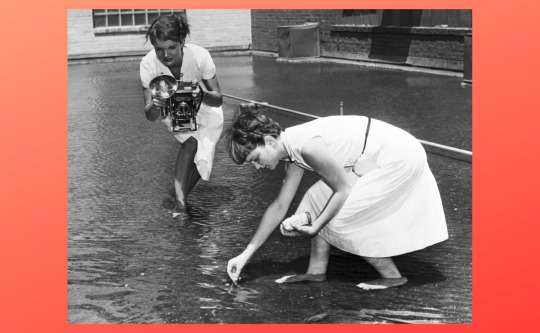
She told Gore Vidal that she once overheard them, recalling that “they spoke of me as if I weren’t a person, just a thing, just a sort of asset, like Rhode Island.”
youtube
Unexpected news about Jackie’s sister was announced in national newspapers on Dec. 12, 1952.
After just nine weeks of work, Lee quit her job and became engaged to Michael Canfield, whose father was the president of the book publisher Harper & Row.
The era’s societal judgment that her younger sister “beat her to the altar” may have prompted a pang of inferiority only reinforced by the continued deafening silence from Jack Kennedy.
Twelve days after he was elected to the Senate, Jack was a groomsman in the Williamstown, Mass., wedding of his friend Robert Kramer.
Ten days later, in the last week of November, he left for a European trip with Torbert MacDonald, a personal friend and political ally since they’d been Harvard roommates.
Torb was not only Jack’s regular companion on overseas trips that had them both womanizing with abandon but a politically ambitious and savvy adviser as well.
(He would seek and win a U.S. congressional seat in 1954.) They went to England, Ireland, Italy, and France, where, in Paris, Jack met with foreign affairs officials to discuss the situation in Vietnam. After three weeks away, Kennedy returned on Dec. 17 and stayed in Boston to preside over a children’s Christmas party at the VFW named for his late brother. His next trip to Washington was to interview candidates for his new Senate staff, not to take Jackie to any holiday parties. The Bouvier stole and gown were seen more on the mannequin than on their creator.
katiecouric.com Inside the Early Courtship (and Complicated Sex Lives) of Jackie Kennedy and JFK Ryan Buxton 16–20 minutes
An excerpt from Camera Girl: The Coming of Age of Jackie Bouvier Kennedy.
Jackie Kennedy is arguably the most famous first lady in American history, and after decades of dissecting everything from her unforgettable fashion to how she influenced our country’s culture, you might think there’s nothing new to learn about this formidable figure. A new book is here to prove that wrong — and uncover a treasure trove of juicy stories in the process.
In Camera Girl: The Coming of Age of Jackie Bouvier Kennedy, author Carl Sferrazza Anthony investigates the early years of the woman who eventually ascended to the White House. The book explores her college years, her formative adventures in Paris, and a notable job you may not have realized she had. The title comes from Jackie’s role in the early 1950s as the “Inquiring Camera Girl” for the Washington Times-Herald. As part of that work, she’d hit the streets to photograph everyday people and ask for their opinion on topical questions that often revealed as much about the woman asking them as the ones who answered.
And while the book is specifically about her pre-White House years, it does chronicle how she got there. In the exclusive excerpt below, the author explores the early courtship of America’s most glamorous couple, including why it took JFK so long to pick a mate, how Jackie ingratiated herself into his influential family, and what the future president’s notoriously voracious sexual appetite meant for their budding relationship.
Unexpected news about Jackie’s sister was announced in national newspapers on Dec. 12, 1952. After just nine weeks of work, Lee quit her job and became engaged to Michael Canfield, whose father was the president of the book publisher Harper & Row. The era’s societal judgment that her younger sister “beat her to the altar” may have prompted a pang of inferiority only reinforced by the continued deafening silence from Jack Kennedy.
Twelve days after he was elected to the Senate, Jack was a groomsman in the Williamstown, Mass., wedding of his friend Robert Kramer. Ten days later, in the last week of November, he left for a European trip with Torbert MacDonald, a personal friend and political ally since they’d been Harvard roommates. Torb was not only Jack’s regular companion on overseas trips that had them both womanizing with abandon but a politically ambitious and savvy adviser as well. (He would seek and win a U.S. congressional seat in 1954.) They went to England, Ireland, Italy, and France, where, in Paris, Jack met with foreign affairs officials to discuss the situation in Vietnam. After three weeks away, Kennedy returned on Dec. 17 and stayed in Boston to preside over a children’s Christmas party at the VFW named for his late brother. His next trip to Washington was to interview candidates for his new Senate staff, not to take Jackie to any holiday parties. The Bouvier stole and gown were seen more on the mannequin than on their creator.
Jackie’s stepbrother Yusha had recently updated her that her former beau, writer John Marquand, had a book that was doing well. “Very pleased to hear his book is to be a Book of the Month,” he informed her.
Months earlier, in a letter to Father Leonard that she wrote after her July visit to Hyannis, she had quoted Byron as saying that love is “woman’s whole existence,” but that men kept it separate from their larger public lives. Her intuition that Kennedy viewed marriage as a political tool was correct. Dave Powers flatly admitted that Jack “wondered about it, whether or not he would have to marry a Massachusetts girl, you know, another Irish girl, this sort of thing. And he waited until he was elected senator to find out whether there was any loss of votes there.” Jackie Bouvier did not yet grasp the extent to which not just Jack but Bobby and their father would ruthlessly evaluate her as a political commodity. She told Gore Vidal that she once overheard them, recalling that “they spoke of me as if I weren’t a person, just a thing, just a sort of asset, like Rhode Island.”
In the weeks after winning the Senate election, Jack mentioned to several close friends that his father was urging him to consider the pursuit of the presidency. Observed Charlie Bartlett, “I think Jack knew the race for the Senate was the beginning of a long race for the presidency. I think Joe had the whole thing sort of in his mind and Jack was ready to go.” Jackie, however, was never one of those who believed Jack became determined to seek the presidency only after winning the Senate and in obeisance to his father. “I think he was probably thinking about it for an awfully long time, long before I even knew,” she reflected. “It was always there.”
By year’s end, it had been nearly three months since she’d seen or heard from Jack Kennedy. She had no sense of whether he had, perhaps, begun dating someone, found some reason to consider her unsuitable for him, or there was some unspoken issue behind his unwillingness to move forward with their relationship. Jacqueline Bouvier (left) photographs a woman feeding goldfish on the rooftop pond of the Washington Times-Herald building in 1952. (Getty Images)
Initially, she presumed that, like many men, he would have to be coaxed into marriage, and her anxiety found its way into her column: “How do you expect to get married?” “How did you propose or how were you proposed to?” “What is your candid opinion of marriage?” “Can you give me any reason why a contented bachelor should get married?” “What is the food of romance?” “The Irish author, Sean O’Faolain, claims that the Irish are deficient in the art of love. Do you agree?”
In early 1952, she had asked, “Should girls take advantage of Leap Year?” Now at year’s end, she returned to the subject, asking, “What advice would you give a girl who wants to marry before Leap Year is out?” Jackie seemed to take aspects of the advice of barber Tom Lascola — “Stop waiting for him to propose to you. Propose to him” — and bookkeeper Jean Pievyak, who advised, “He’ll get scared . . . sit tight and wait until next year.”
While Jackie wouldn’t propose, neither would she wait.
Ambassador Joe Kennedy was already in residence at the family’s Palm Beach home by the time the senator-elect arrived on Dec. 21, joined by all the family by Christmas Day. Before Jack arrived, however, Jackie came to see his father.
Some thirty years later, the historian and former Newsweek editor Ralph G. Martin left a brief record of an overlooked incident that seems consequential at this critical point in Jacqueline Bouvier’s trajectory. It involved the “mutual affection” that was “quick and lasting” between her and the ambassador, as Martin termed it: “She was vacationing with the Auchinclosses at Hobe Sound, and dropped in on the Kennedy home in Palm Beach. Only the father was there. The two seemed determined to charm each other, and they did. They went swimming, made each other laugh, talked about everything from Cardinal Spellman to Gloria Swanson. When she left, she had an ally and an admirer.”
As Jackie would later observe, “I’m more like Mr. Kennedy senior than any other members of his family.” The family’s friend Robin Douglas-Home, the British pianist and author, asserted that “the only one who really knew her worth from the beginning was Joe Kennedy.”
Jack Kennedy’s friend and colleague Florida senator George Smathers would later claim that Jack “told me that his father told him it was time to get married, and his father preferred Jackie.” His more intimate confidant Lem Billings disputed this: “Nobody would have talked to Jack at 35 that way, including his father,” especially since Jack “had thousands of girls” from whom he could make his own marital choice. If the ambassador was making arrangements to advance Jack’s best interests, however, “Mr. Kennedy didn’t ever let Jack know it,” Billings added. The Kennedy family poses for a portrait in Hyannis, Massachussetts, during the 1930s. A young JFK is at the center. Patriarch Joseph Kennedy, who bonded with his son’s future wife early on, is seated on the right. (Getty Images)
Within days after Jackie’s meeting with the ambassador alone, there appeared two items in nationally syndicated gossip columns. In her column “The Gold Coast,” appearing in the Dec. 21 Miami Daily News, Aileen Mehle reported, “Senator-Elect Jack Kennedy, who is one of the matrimonial catches of the decade, what with being young, intelligent, good looking, and rich (but not well groomed) is pretty excited about Mrs. Hugh Auchincloss’s daughter Jackie Bouvier, who is young, intelligent, good looking, rich, and very well groomed.” Two days later, on Dec. 23, Dorothy Kilgallen, who wrote the “Voice of Broadway” column, predicted that “U.S. Senator-elect Jack Kennedy and lovely socialite Jacqueline Bouvier will waltz down the aisle early in 1953.”
It was the first time Jackie and Jack were linked together in the press. Had the Ambassador been the source for the tips? If so, it was not the first time that Joe Kennedy had used his wide network of personal contacts in the press to plant a story about his son’s private life, without his knowledge, to serve what he believed to be the best interests of Jack’s career.
On Jan. 3, shortly after the gossip items linking them were published, Jack invited Jackie out. The previous winter, on their first “date” at the Blue Room, he had requested that Dave Powers join them. This time, Jack asked along Lucy Torres, Jean Mannix, Lois Strode, Mary Gallagher, and Evelyn Lincoln, women on his new Senate staff. The “date” was the Eighty-Third Congress’s opening session, when he would be sworn in as a U.S. senator. They, along with his new colleagues and family members, watched as he was escorted onto the Senate floor — certainly more exclusive company than the thousands of women at the campaign tea party when Jackie had last seen him, but it was still a public event, hardly an opportunity for them to reconnect in a personal way.
Further underscoring the point: Three days later, Jack attended an annual New York charity ball with the striking Maria Carmela Attolico, daughter of the former ambassador to Germany. At the same time, he was also pursuing Betsy Finkenstadt, sister of one of Bobby Kennedy’s groomsmen, though Lem Billings thought it was simply because “he never was successful in interesting her.” Asked by a reporter if he was “swamped” with marital offers from women, Kennedy jibed, “You would think so, but nothing seems to happen.”
Just as with his carefully plotted long game to win the Senate seat, however, Jack Kennedy was methodically laying out his plans for the next momentous chapter of his life. And just like Jackie, when the issue was serious, he kept his own counsel.
Thus it came as a complete surprise to her when, at some point in the first two weeks of 1953, Senator Kennedy asked Miss Bouvier to be his date to the presidential inaugural ball. John and Jacqueline play baseball at the Kennedy family’s Hyannis Port compound in June 1953. (Getty Images)
But as the relationship developed, Jackie was divesting herself of a traditional concept of marriage. A monogamous husband could not be expected in the partnership she was pursuing, but the relationship would grant her the opportunity to employ her talents and maintain independence while also giving her the status and stability of a financially flourishing husband and household. That was the scenario Jack Kennedy seemed to offer Jackie with the approach of spring in 1953.
Over time, she would come to see the degree of his compulsive promiscuity to be as much of a chronic condition as his painful back, which occasionally required him to depend on crutches. It would nevertheless prove to be a formidable “challenge,” as she seemingly lightly characterized it, to accept his sexual intimacy with other women as an analogous crutch.
In the decidedly conservative early 1950s, dating and marriage were highly idealized. Yet the famous Kinsey reports, done in 1948 and 1953, concluded that about 50 percent of all husbands committed adultery; other studies suggest it was about 33 percent who did so at least once, although these studies did not make a distinction between sexual and emotional monogamy. Based on extensive research, anthropologist Helen Fisher concluded that “we have two brain systems: one of them is linked to attachment and romantic love, and then there is the other brain system, which is purely sex drive.” Jack Kennedy was the embodiment of this theory.
Once again, Jackie used her column as a mode of research, with question after question about romance, marriage, and infidelity. What she did not — and could not — know in February 1953 was how differently Jack Kennedy was treating her from other women he’d been involved with. His history with women had patterns — but his relationship with Jackie didn’t fit any of them.
As Lem explained, although Jack was “crazy about girls,” he “never really settled down with one girl.” A big part of the reason, his confidant pointed out, was that Jack had “an immature relationship with girls — that is while he was terribly interested in going out and having fun with them at night, I don’t think that he was really terribly excited about having girls as friends.” Bill Walton concurred: “He was very attentive, flirtatious; but if a woman bored him, he would drop her quicker than any known man.”
Other than suggesting he couldn’t help himself and that it was a habit indulged sometimes daily, Kennedy never speculated on what he thought were the psychological reasons for his sexual compulsion. As Chuck Spalding said, “He wasn’t by nature given to that kind of prolonged introspection.” Jack may have avoided thinking about the root cause because he never felt there was anything wrong with being compulsively sexual. The most frequent explanation given was the example and encouragement of his father. It was not merely that the ambassador took unapologetic pleasure with whomever he wished, but he had also encouraged his sons to do so at an early age.
Jack’s awareness of how suddenly death could come may have been another factor leading him to seek pleasure in life while he could. By the time he met Jackie, he had lost his siblings Joe Jr. and Kathleen in plane crashes, and he himself had come close to death three times. The first was when he was only three years old, delirious with scarlet fever. The Latin incantations of the Last Rites of the Catholic Church were shouted above the little boy in bed. He received the Last Rites on two other occasions (in 1947, while crossing the Atlantic, and in 1951, in Tokyo), due to complications from Addison’s disease. Perhaps the most acute observation on the matter came from Spalding, who saw that Jack lived with a “heightened perception about the brevity of life.” Although Jackie had no such brushes with death, she shared his habit of “surveying the scene with a kind of detachment.”
The motives and desires that brought Jack and Jackie together are typically said to have been sex on his part and money on hers. Often neglected, however, has been the full consideration of their mutual ambition.They shared a vision of a free and democratic world and wanted the sort of power that would allow them to encourage its realization. The president and first lady in later years, after they’d made their relationship official with a spectacular wedding. (Getty Images)
As the spring of 1953 approached, Jack entrusted a special project to Jackie that served to prove to her that he was the sort of partner she’d longed for but had come to believe was impossible to find. It would demonstrate that he wanted to join forces with her, not merely appreciating her intellectual ability as a sort of trophy but wanting her to put it to use. It would make him irresistible to her, and propel what became, arguably, the most momentous decision of her life.
Feb. 10 and 20 were the first times that Miss Bouvier’s name was written into the official record of the senator’s business schedule, and it may have been on one of these significant dates when they first discussed what the project would entail.
Kennedy intended to become a national leader on the issue of the growing controversy over aid the United States was providing to support France in defending its colonial control of Indochina, most specifically in Vietnam, against the increasing success of Communist guerilla fighters based in northern Vietnam, backed by China. He needed to first become an expert on the issue and fully understand the complex history of France’s presence there and its justification for delay in granting Vietnam full independence. He needed the help of Jackie Bouvier.
Excerpted from Camera Girl by Carl Sferrazza Anthony. Copyright © 2023 by Carl Sferrazza Anthony. Reprinted by permission of Gallery Books, a Division of Simon & Schuster, Inc.
What First Lady Jacqueline Kennedy really thought about who killed her husband is not known, though she was certainly skeptical of the Warren Commission’s improbable single bullet theory.
The former First Lady gave four confidential interviews to historian William Manchester in 1964 in which she spoke candidly about who she thought was behind her husband’s murder.
She also sent three letters to President Lyndon Johnson that are sealed.
Jackie’s private views might not amount to smoking gun proof of conspiracy, but they probably show that the closest witness to the crime thought her husband was killed by domestic enemies — which would be newsworthy to say the least.
The tapes and transcripts of those conversations, however, are controlled by JFK’s daughter, Caroline Kennedy, who is RFK Jr.’s cousin.
The tapes and Jackie’s correspondence are under a deed of gift seal until 2067.
And the Kennedy family is divided over RFK Jr.’s candidacy.
Which is all the more reason for a new JFK Records Act: to prevent a family dispute from obstructing the public interest in full disclosure.
0 notes